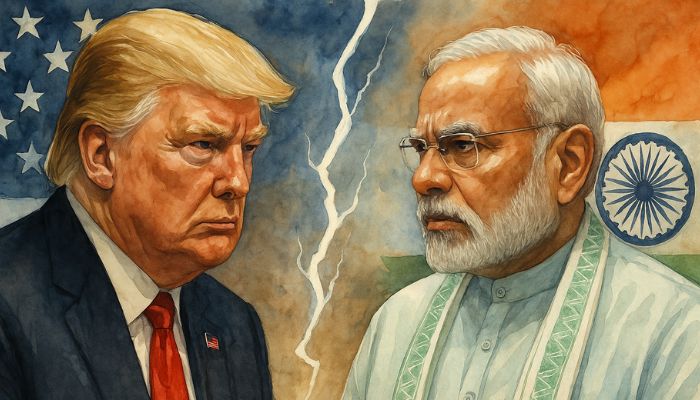On 6th August (local time), President of the United States, Donald Trump, signed an executive order imposing a fresh 25% tariff on Indian goods. The additional duty, according to Trump, has been imposed in response to India’s continued imports of Russian oil. The additional tariff has taken the overall burden on selected Indian goods to a staggering 50%.
While the step is likely to cause turbulence for sectors like textiles, leather, seafood and chemicals, all India needs to do is diversify its export basket and work on ties with other nations, which will help cushion the long-term impact.
Who is affected and when will it kick in?
The first 25% tariff, which was part of Trump’s earlier trade tightening measures, takes effect on 7th August. The second tranche, which was announced on 6th August, will come into force on 27th August. Together, they will double the cost burden on Indian goods entering the US market, making them significantly less competitive compared to products from countries including Vietnam, Malaysia, and even China.
Among the sectors that will feel the most heat are textiles and clothing (₹85,000+ crore exports to the US annually), gems and jewellery (₹1 lakh crore+), shrimp and seafood, leather and footwear, organic and inorganic chemicals, and electrical and mechanical machinery.
For example, shrimps going to the US from India are already subject to anti-dumping and countervailing duties totalling 8.26%, which will now attract a 33.26% duty from 7th August. Apparel (both knitted and woven), carpets, diamonds, and machinery are also slated to attract total levies exceeding 50%, according to estimates by think tank GTRI.
Is it a knockout blow? Not quite
The Federation of Indian Export Organisations (FIEO) has warned that nearly 55% of India’s US-bound exports will now be impacted. However, the overall impact of the tariff may be brief.
Pharmaceutical and electronic exports are the two high-performing categories. They have not been touched in the new tariffs imposed by the US. These account for a sizeable chunk of bilateral trade. Moreover, New Delhi has long been working to expand its trade partnerships across Europe, Africa, the Middle East and ASEAN, which will eventually reduce the overdependence on the US.
According to Chief Economist, ICICI Securities Primary Dealership, A Prasanna, the 50% tariff “creates a disadvantage” but India continues to enjoy access to several tariff-exempt categories. Not to forget, India always has room to pivot to new markets in case the US continues to pressure India with tariff impositions.
Pressure tactic, not permanent policy?
The sudden escalation may have more to do with Trump’s characteristic deal-making style than long-term policy. Representatives from the US are scheduled to come to India to have talks on trade by the end of August. Imposition of such high tariffs might be just a pressure tactic to push India to reduce oil purchases from Russia and push India to buy oil and defence equipment from the US.
The tariffs are widely seen as an attempt to push India to concede ground in the pending India-US trade deal. Washington has been pressing New Delhi to lower tariffs on sectors including electric vehicles, dairy, apples, and genetically modified crops, all contentious items that New Delhi has resisted. Furthermore, the US has been pressuring India to allow dairy products from the US into the Indian market but India has categorically denied this because of their non-vegetarian nature.
Trump’s decision also aims to corner India on its continued Russian oil imports, even though India has repeatedly emphasised that its purchases are guided by domestic energy needs and market pricing, not politics.
Agneshwar Sen, Trade Policy Leader at EY India, has called the development “disappointing”, especially at a time “when both sides are making efforts to resolve past issues. Political differences are best resolved through mutual dialogue, not tariffs.”
How did India respond?
India has responded strongly and called the decision “unfortunate, unfair and unreasonable”. The Ministry of External Affairs stressed that oil procurement decisions are dictated by energy security considerations for a population of 1.4 billion and that many countries purchasing Russian oil have not faced such punitive measures.
Statement by Official Spokesperson⬇️
🔗 https://t.co/BNwLm9YmJc pic.twitter.com/DsvRvhd61D— Randhir Jaiswal (@MEAIndia) August 6, 2025
The ministry added, “India will take all actions necessary to protect its national interest.”
What is next for Indian exporters?
There is no doubt that exporters are going to face a squeeze as American buyers may pause and try to renegotiate contracts. In MSME-led sectors including gems, garments and seafood, margins are already tight and sudden duties could disrupt long-standing relationships.
However, India is already exploring opportunities in the EU, Africa, West Asia and Southeast Asia. With the global demand for Indian goods like pharma, textiles, IT services and electronics on the rise, the long-term prospects remain resilient.
Bottom line
Trump’s 50% tariff move may create temporary challenges for Indian exporters. However, it is not the beginning of a full-blown trade crisis. India’s export base is robust and its trade alliances are expanding. India’s economy is far more resilient than it was during previous tariff wars. With deft diplomacy and market diversification, India is likely to weather this storm and emerge stronger.

